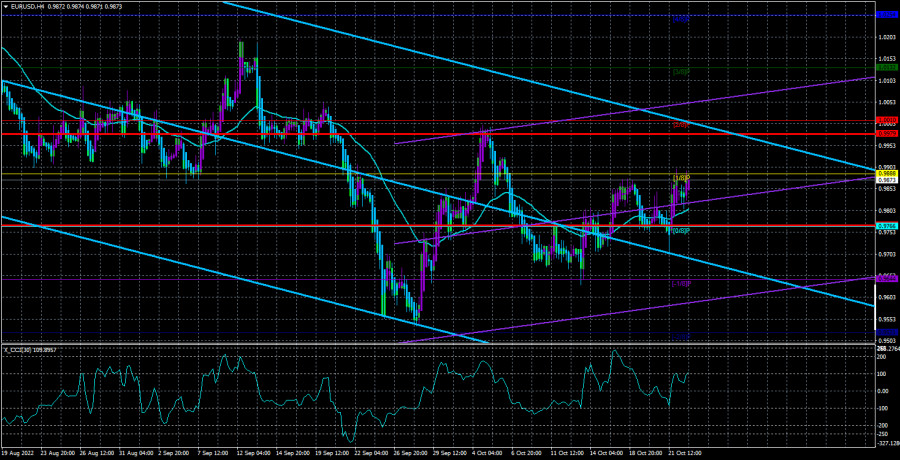

The EUR/USD currency pair "calmed down" on Monday after a volatile Thursday and Friday. Trading occurred slightly above the moving average line, and no major price changes were observed. Also, there was no usual volatility surge in the American trading session. However, now the main thing is to understand what kind of movement we are dealing with clearly. From our point of view, we are now seeing some form of "swing" - the price often rolls back, often reverses, and often corrects, but there is no clear trend. Formally, there is a slight upward slope in the movement. However, we said last week that the euro/dollar pair is now just consolidating around the 98th level. The illustration above clearly shows that each next turn of the movement is weaker than the previous one. All this can end in a banal flat.
In the last article, we discussed what we could expect from this week. There will be a few important fundamental events, but only the ECB meeting can be singled out. The problem with every central bank meeting is that the decision that will be made is often known in advance. Even now, opinion polls among economists show that almost everyone believes in an ECB rate hike of 0.75%. We agree with this forecast since inflation in the EU continues to grow, and the rate has grown too weakly to expect a serious slowdown in the rate of price growth in the near future. However, will a 0.75% rate hike help the European currency?
Recall that the price continues to be close to its 20-year lows. This means that there are no or almost no bulls in the market. The ECB has already raised the rate twice, not "for a show," but by 1.25% in total, and the euro currency could not benefit from this. Thus, it seems that for most market participants, there is only the US dollar right now. Their logic is as follows: why buy a euro currency with absolutely incomprehensible prospects for the European economy if the dollar is stable? The United States is far from the geopolitical conflict in Ukraine, does not depend on energy resources from Russia in any way, and does not experience any problems at all, except for high inflation, which has already begun to decline. Therefore, we believe the euro will not show strong long-term growth if the rate increases by 0.75%. Moreover, the market could already take into account this increase.
What to expect from Christine Lagarde?
The main characteristic of any monetary policy is "sluggishness" in the good sense of the word. When it comes to managing the economy of an entire country, a soft and smooth change in the parameters of monetary policy is required, and then many months to evaluate the impact. The change rate is slow and cannot be raised immediately to the required value. Moreover, the rhetoric of the top officials of any central bank also changes quite rarely.
In one of her last speeches, Christine Lagarde said it would take 2 to 5 meetings to raise the rate to the required level. She did not say the required level, but we do not believe that the ECB can raise the rate to 4% or 5%. We have already written earlier that there are problematic Greece, Spain, and Italy in the European Union, whose economies barely survived the pandemic. If their public debts grow and their budget deficits grow, the European Commission will again have to provide them with all possible assistance. At the expense of other, more prosperous countries. Therefore, the ECB will stay "somewhere in the middle." It will raise the bid, but not as high as we would like. Inflation will slow down, but not as much as we would like. However, the rate is at 1.25% so far, so even the ECB is too early to think about completing the policy tightening cycle. Therefore, we do not doubt that the rate will be increased by 0.75%, and Christine Lagarde will announce at a press conference that the rate will continue to rise. The only question is at what pace and for how long. The answers to these questions can either support the euro or put pressure on it. The more the rate increases in the future, the more chances for growth in the euro currency.

The average volatility of the euro/dollar currency pair over the last five trading days as of October 25 is 105 points and is characterized as "high." Thus, on Tuesday, we expect the pair to move between the levels of 0.9769 and 0.9979. A reversal of the Heiken Ashi indicator downwards signals a new round of downward movement.
The nearest support levels:
S1 – 0.9766
S2 – 0.9644
S3 – 0.9521
Nearest resistance levels:
R1 – 0.9888
R2 – 1.0010
R3 – 1.0132
Trading Recommendations:
The EUR/USD pair continues to be near the moving average. Thus, it would be best if you stayed in long positions with targets of 0.9888 and 0.9979 until the Heiken-Ashi indicator turns down. Sales will become relevant again no earlier than fixing the price below the moving average with a target of 0.9644. The probability of a "swing" is high at this time.
Explanations of the illustrations:
Linear regression channels help determine the current trend. The trend is strong if both are directed in the same direction.
The moving average line (settings 20.0, smoothed) – determines the short-term trend and the direction in which trading should be conducted now.
Murray levels are target levels for movements and corrections.
Volatility levels (red lines) are the likely price channel in which the pair will spend the next day, based on current volatility indicators.
The CCI indicator – its entry into the oversold area (below -250) or into the overbought area (above +250) means that a trend reversal in the opposite direction is approaching.